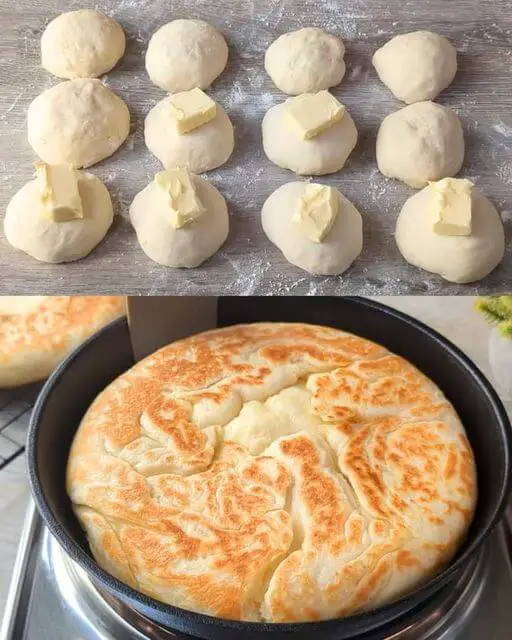Delicious Bread Recipe
Table of Contents
Ingredients:
-
- 1 cup warm water (200 ml)
- 1 tablespoon yeast (10 grams)
-
- 4 teaspoons sugar
- 1/3 cup vegetable oil (60 ml)
- 1 cup warm milk (200 ml)
-
- 1/2 teaspoon salt
- 5 cups of flour (600 grams) + 30-50 grams for working with the dough
- 100 grams butter
Note: The glass used for measuring is 200 ml.
Instructions:
-
- Activate the Yeast:
Begin by combining the warm water, yeast, and sugar in a large mixing bowl. Stir gently to dissolve the yeast and sugar. Let the mixture sit for about 5-10 minutes, or until it becomes frothy and bubbly. This step ensures that the yeast is active and ready to work its magic in the dough. - Mix the Wet Ingredients:
Once the yeast has activated, add the vegetable oil and warm milk to the bowl. Stir well to combine. The warmth of the milk and water helps create an ideal environment for the yeast to thrive, resulting in a light and airy bread.
- Activate the Yeast:
-
- Incorporate the Dry Ingredients:
Gradually add the flour and salt to the wet mixture, one cup at a time, stirring with a wooden spoon or spatula. As the dough begins to form, you may need to use your hands to bring it together. Continue adding flour until the dough is soft but not sticky. - Knead the Dough:
Transfer the dough to a lightly floured surface and begin kneading. Kneading is a crucial step in developing the gluten, which gives the bread its structure and texture. Knead the dough for about 10 minutes, or until it becomes smooth and elastic. If the dough is too sticky, add a little more flour, but be careful not to overdo it. - First Rise:
Place the kneaded dough in a large, greased bowl, and cover it with a clean kitchen towel. Allow the dough to rise in a warm, draft-free place for about 1-2 hours, or until it has doubled in size. This first rise allows the yeast to ferment, creating the gas bubbles that will make your bread light and fluffy.
- Incorporate the Dry Ingredients:
-
- Shape the Dough:
Once the dough has risen, punch it down gently to release the air. Turn it out onto a floured surface and knead it briefly. Then, divide the dough into two equal portions. Shape each portion into a loaf by flattening the dough into a rectangle, folding the sides in, and then rolling it up tightly. Pinch the seams to seal. - Second Rise:
Place the shaped loaves in greased loaf pans, cover them with a towel, and let them rise again for 30-45 minutes, or until they have doubled in size. This second rise gives the bread its final shape and allows the gluten to relax, resulting in a tender crumb. - Preheat the Oven:
While the dough is rising, preheat your oven to 180°C (350°F). Ensuring the oven is properly preheated is key to achieving an even bake.
- Shape the Dough:
- Bake the Bread:
Once the loaves have risen, place them in the preheated oven and bake for 25-30 minutes, or until the tops are golden brown and the bread sounds hollow when tapped. If the tops brown too quickly, you can tent them with aluminum foil. - Butter the Crust:
As soon as the bread comes out of the oven, brush the tops with melted butter. This adds a rich flavor to the crust and gives it a beautiful shine. Let the loaves cool in the pans for a few minutes before transferring them to a wire rack to cool completely.
Cooking Tips:
-
- Measuring Flour: When measuring flour, spoon it into the measuring cup and level it off with a knife. This prevents over-packing, which can lead to dense bread.
-
- Room Temperature Ingredients: For best results, make sure all ingredients are at room temperature before starting. This helps the yeast activate more effectively.
- Check for Doneness: If you’re unsure whether the bread is fully baked, insert an instant-read thermometer into the center of the loaf. It should read between 190°F (88°C) and 200°F (93°C).
- Storing Bread: Store leftover bread in an airtight container at room temperature for up to three days. For longer storage, wrap the bread tightly in plastic wrap and freeze it for up to three months.
Nutritional Benefits:
This bread is not only delicious but also provides essential nutrients. The yeast in the bread is a good source of B vitamins, which support energy production and healthy brain function. The flour used in the recipe contains carbohydrates, which are your body’s primary source of energy. Additionally, the butter adds a touch of healthy fats, which are important for absorbing fat-soluble vitamins and providing long-lasting energy.
Why You’ll Love This Recipe:
You’ll love this bread recipe because it’s incredibly versatile and reliable. Whether you enjoy it warm with butter, toasted with jam, or as a base for your favorite sandwich, this bread is sure to satisfy. The soft, tender crumb and slightly sweet flavor make it a perfect complement to both savory and sweet toppings. Plus, the recipe is easy to follow, with ingredients you likely already have in your pantry. It’s a recipe that has stood the test of time, delivering consistent results every time you bake it.
Dietary Information:
This bread recipe contains gluten, dairy, and yeast. For those with dietary restrictions, it can be adapted by using gluten-free flour blends, plant-based milk, and dairy-free butter. The recipe can also be made vegan by substituting the butter with a vegan alternative and using a plant-based milk. For those reducing their sugar intake, the amount of sugar can be reduced or replaced with a natural sweetener like honey or agave syrup.

